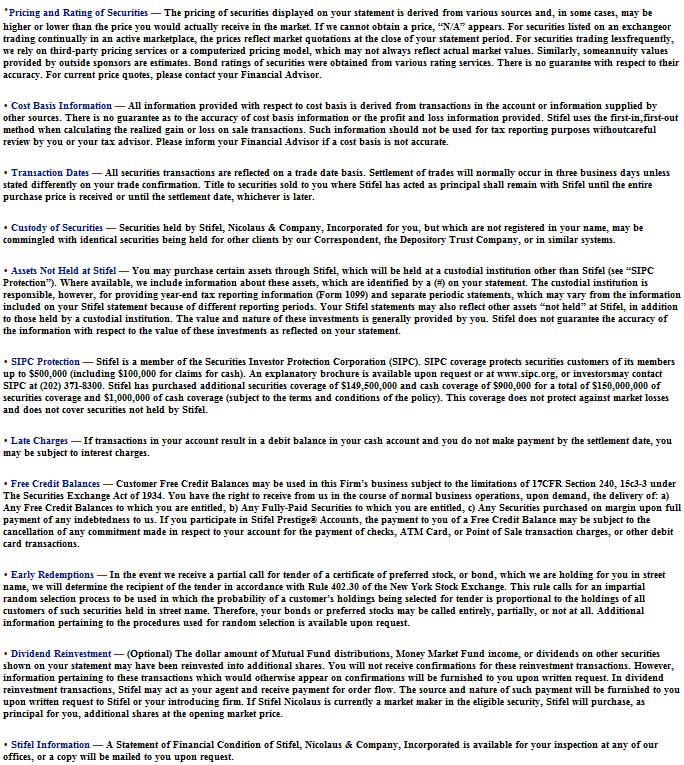|
ROLLOVER
CENTER |
| |
|
| |
STIFEL NICOLAUS |
| |
|
|
Investment StrategistTM
Understanding Interest Rates
August 2008
|
At its
most recent meeting, the Federal Reserve (the Fed) decided to
leave the federal funds rate � the rate banks charge each other
for overnight loans � unchanged. It was the first time in 10
months that the central bank did not cut rates. Overall, during
the past few years we�ve witnessed historically low interest
rates. However, just as the stock market experiences volatility,
interest rates also fluctuate and could possibly rise at some
point in the future. With this in mind, it is important that
investors have an understanding of what will happen when interest
rates finally do rise. |
 |
Why the Federal Reserve Adjusts Rates
The Fed typically adjusts the federal funds rate for two reasons. One
reason is to slow down or speed up the economy. The Fed may see fit to
raise interest rates in order to slow down the economy and to help
control an increase in inflation. The Fed may also adjust interest
rates during a recession to help spark the economy, as consumers are
better able to secure new loans for cars, homes, and other goods and
services when interest rates are lower.
Many economists claim that an adjustment to interest rates by the Fed
can take 6 to 12 months before the full effect is realized. However,
rate changes often have an immediate psychological effect on
investors, especially if the change is unexpected.
Effects of
Interest Rates on the Stock Market
Simply put, when interest rates are higher, stock prices often go
down. And when interest rates are lower, stock prices often go up.
This is because interest rates offer direct competition to the stock
market. If investors feel they can get a good return on bonds because
of high interest rates, they may avoid investingtheir funds in the
stock market, which typically holds greater risk.
Effects of
Interest Rates on Bonds
Bond investors should note that as interest rates change, so do the
values of existing bonds in the marketplace. As interest rates rise,
bond holders will find that their fixed income securities will be down
in

V i s i o n
� P l a n n i n g
�
Focus
SNINS060801 |
|
|
|
Understanding Interest Rates
|
|
|
|
price in
order to reflect a higher level of interest rates in the marketplace.
If a bond investor holds onto the bonds until maturity, rising rates
will not have an effect on the income he or she receives or the
maturity value, for when the matured bond is redeemed, the investor
will receive back the face value (par) of the bond. Prior to maturity,
the investor will continue to earn or accrue interest at the rate that
was promised when the bond was purchased.
For example,
if an investor were to purchase a ten-year U.S. Treasury Note with a
face value of $1,000 and an interest rate of 4%, and were to hold this
bond until maturity, he or she would receive $40 each year for ten
years and would receive the original $1,000 investment upon maturity.
Investors should note that if they need to sell their bonds prior to
maturity, and interest rates have gone up, the value of the bond they
are selling may have decreased, and they may have to sell it at a
loss.
Building a
Laddered Portfolio
Because
interest rates do fluctuate, bond investors can utilize a strategy
known as �laddering� to help balance risk and return in their bond
portfolios. To build a laddered portfolio, investors purchase a
collection of bonds with different maturities spread out over their
investment time frame. By staggering maturities, investors may be able
to reduce the impact that changes in interest rates can have on their
portfolio.
For example,
an individual who wishes to create a laddered portfolio could purchase
bonds that mature each year during a span of ten years. By using a
rollover strategy as well, when the first bond matures, the investor
could reinvest those funds in a bond that matures in ten years. As
each bond matures, the investor would continue this process. After ten
years, the investor would own all ten-year bonds, with one maturing
every year. By laddering the bond portfolio, an investor can worry
less about fluctuations in interest rates.
If interest
rates rise, the investor knows that he or she will soon have money
available, from a maturing bond, to take advantage of a new bond. If
interest rates should fall, then the investor has at least managed to
secure higher rates for a portion of their portfolio. This strategy
can also be used with CDs.
Review Your
Current Portfolio Strategy
It is
important for investors to remember that investing in the stock market
should be for the long term. An investor�s goals, tolerance for risk,
ability to invest, and investment time horizon should all be carefully
evaluated in order to create a fully diversified portfolio consisting
of stock, bonds, and cash. While diversification does not ensure a
profit or protect against loss, by being properly diversified and
using bond-laddering techniques, investors can better withstand market
volatility and changes in interest rates. Visit with your Stifel
Financial Advisor if you have any questions about your portfolio
strategy.

|
|

|
Treasury Inflation-Protected Securities |
Treasury
Inflation-Protected Securities
Worried
about inflation? One way of combating inflation risk is by investing
in treasury inflation protected securities (TIPS). Not only does this
investment instrument help protect against inflation, it also
provides a
real rate of return that is guaranteed by the U.S. government.
With normal
fixed income investments, investors bear inflation risk in that the
purchasing power of interest payments could be eroded by inflation
over and above their original expectations. TIPS, however, are
guaranteed to keep pace with inflation because their principal is
adjusted with changes to the Consumer Price Index (CPI), which is
published by the Bureau of Labor Statistics. With inflation (a rise in
the index), the principal increases. With deflation (a drop in the
index), it decreases. When the security matures, the U.S. Treasury
pays the original or adjusted principal, whichever is greater.
The
relationship between TIPS and the Consumer Price Index affects both
the sum you are paid when your TIPS mature and the amount of interest
that a TIPS pays you every six months. TIPS pay interestat a fixed
rate. Because the rate is applied to the adjusted principal, however,
interest payments can vary inamount from one period to the next. If
inflation occurs, the interest payment increases. In the event of
deflation, the interest payment decreases.
TIPS pay
interest every six months, based on a fixed rate applied to the
adjusted principal. Each interest payment is calculated by multiplying
the adjusted principal by one-half the interest rate.
If you�re
interested in learning more about TIPS or the potential impact that
interest rate changes can have on the investments in your portfolio,
contact your Stifel Financial Advisor today.
|
� TIPS are sold with 5-, 10-, and 20-year
maturities and can be purchased for a minimum of $1,000 and
multiples thereof.
� Five-year TIPS are auctioned in April and
October, 10-year are auctioned in January, April, July, and
October. The 20-year TIPS are auctioned in January and July.
� To buy at auction, you must place a bid. (You
can do this through your Stifel Financial Advisor.)
� Because of the inflation protection, TIPS
typically offer a lower rate of interest than other 10-year
Treasury securities that don�t have the feature. TIPS are subject
to federal income tax, but not state or local taxes.
� Keep in mind that in addition to paying tax
annually on the interest you receive, you�ll also have to pay tax
each year on any increases to the principal, even though you won�t
receive the inflation-adjusted principal until the bond matures.
For this reason, it�s best to hold TIPS in a tax-deferred account
or a Roth IRA.
Source: Bankrate.com
|



Stifel, Nicolaus & Company, Incorporated
� Member SIPC and New York
Stock Exchange
� One
Financial Plaza, 501 North Broadway, St. Louis, Missouri 63102
� www.stifel.com
|
|
|



